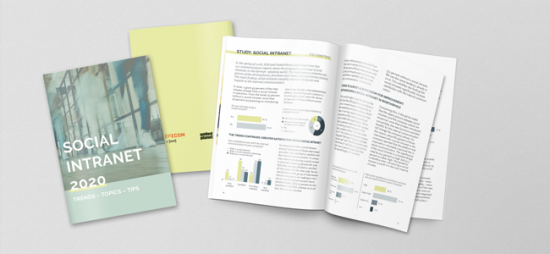You may have heard about social advocacy and how it can move mountains for your organization; but what is it exactly and how can it help you? Before launching an entire program for employee social advocacy, first take stock of your existing internal communications, examine how it can fit inside your global strategy, and determine what goals you want to accomplish.
The current state of internal communications in the enterprise
While internal communication teams are facing renewed challenges today, they are also contending with a plethora of new tools to assist them on a daily basis inside the digital workplace. Some such tools are leading collaborative suites and social intranets to streamline communication, collaboration and workflows, as well as chats to facilitate real-time discussions. It can be difficult to know which tools your enterprise really needs in order to evolve and reach its next iteration.
One major trend affecting today’s digital workplace is to mix tools, in order to achieve a more holistic approach to enterprise communications. This is where social advocacy comes in; by leveraging employees, it acts as an extension of internal communication to reach an external audience and creates a window into the company.
Along with these new tools, there are some misgivings still lingering in corporate culture which can hinder effective transformation. For example, certain company cultures exhibit a lack of transparency and trust toward their employees, which can make it difficult to implement a social advocacy program. What’s more, faced with the potential of social advocacy, many enterprise communication teams may be reluctant to publish internal content to external audiences. These fears can be quickly assuaged with the right tool. Notably, the right employee advocacy tool gives program managers complete control over what content is shared to the public.
What is Social Advocacy for business?
So what can social advocacy do for your organization? There are a few types of social advocacy, each serving different business goals and differentiated by where their message originates.
Types of social advocacy:
- Employee advocacy
This type of advocacy is when employees take action to promote their employer on their personal networks. These efforts generally take place on social media such as LinkedIn, Twitter, Facebook or other popular platforms.
- Corporate advocacy
This advocacy happens when a company uses its influence publicly and in business operations to share support for a social, environmental, or political cause. The messages usually originate from company leaders or a corporate communications team.
- Brand advocacy
This refers to when any advocate (whether employee, influencer, or customer) shares a positive message about a product or a specific brand. These types of messages lead to word-of-mouth advertising in external networks, outside the company’s own.
We are focusing here on the first type, employee advocacy, where messages are shared by workers from inside the organization.
Benefits of Social Advocacy for business
It is common for companies to spend large sums in advertising, social media campaigns and other more risky marketing strategies. But the truth is, social advocacy can be a very effective tool to promote your brand, without breaking the bank. A well-run program can benefit both your employees at an individual level and your organization on a global scale.
Benefits to your employees
Employee advocacy lets you leverage work done in internal communication, so it can also serve external communication and highlight the work done internally by your teams.
This type of program also increases employee engagement. Enabling employee advocacy shows that you trust your employees, by giving them responsibility to share content and guiding them to become ambassadors.
Employees can also easily use employee advocacy to enhance their personal brand image. In this way, your advocacy program is helping employees to progress in their own professional journey.
Benefits to the organization
Lastly, employee advocacy strongly benefits recruitment efforts. Job seekers are looking for specific information about the company before deciding to formally apply for an available position. Employee advocacy allows job seekers to get an inside view and “meet” their future coworkers, so your company can distinguish itself from the pack. By enhancing brand reputation, and building better and more effective employee networks, your trustworthiness as a potential employer will help to attract and retain top talents, which is both a benefit for employees and the organization overall.
Most of all though, employee advocacy helps you to create more awareness and reach a wider audience, which means you capitalize on marketing efforts in order to reap more benefits. Did you know that on average, personal social networks reach ten times more followers than a corporate brand account?
Introducing an employee advocacy program is an excellent way to not only expand the brand’s reach, but also increase brand trust. The reason this works is that by letting your employees promote your company, you are imbuing your brand image with transparency and projecting a more personalized, approachable image. As the public gets to “know” the people inside the company, potential customers are more likely to trust ambassadors and relate to more authentic messages.
Combined, these two positive effects can lead to more sales and revenue, thanks to a more personalized buyer process.
Hungry for more? Visit the LumApps blog for more reading on Social Advocacy and discover our solution LumApps Employee Social Advocacy.
This article is based on a web session at the European Internal Comms conference July 14th.
Couldn’t make the live event? The recordings are available now. Get on-demand access here: Internal Comms Conference.
Author:

Maya Riebel is Communications Manager at LumApps, a leading provider of cloud solutions for organizations who wish to enhance their digital workplace, connecting over 4 million users across the world. Maya manages external communication and public relations for LumApps, creating and sharing valuable content for deciders in large enterprises.









